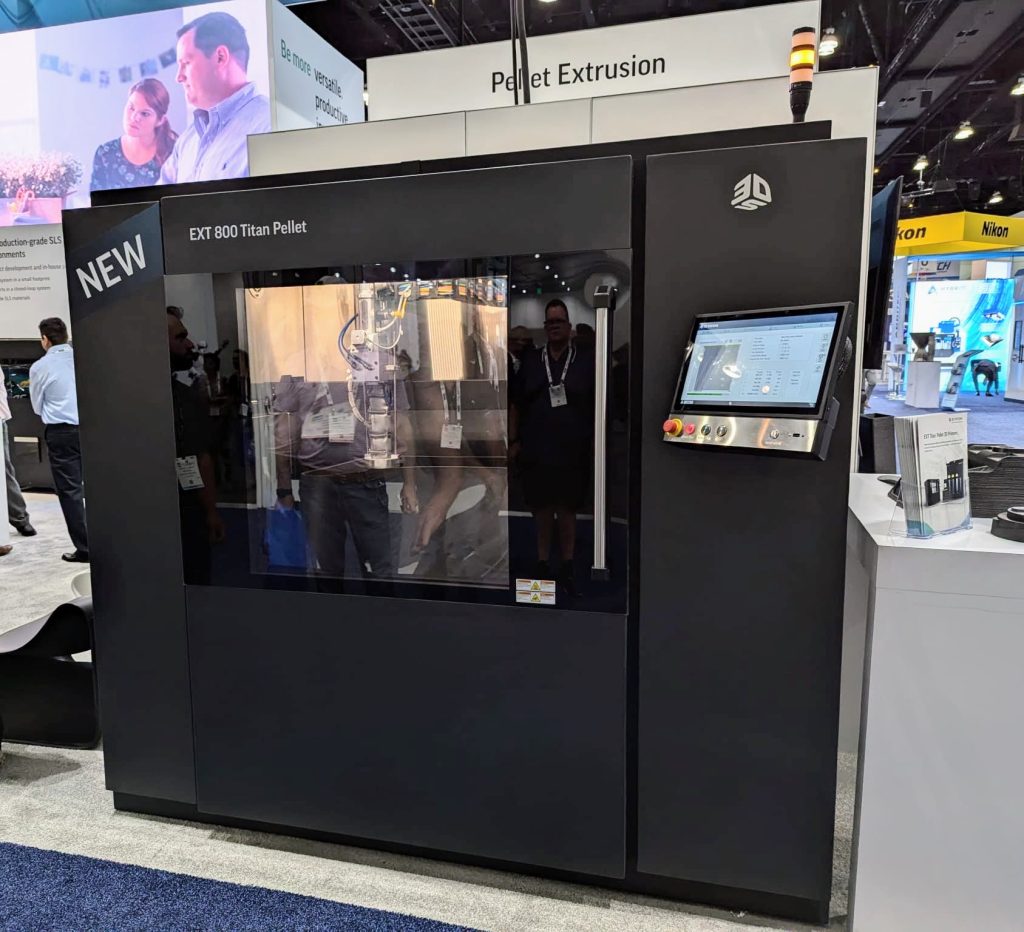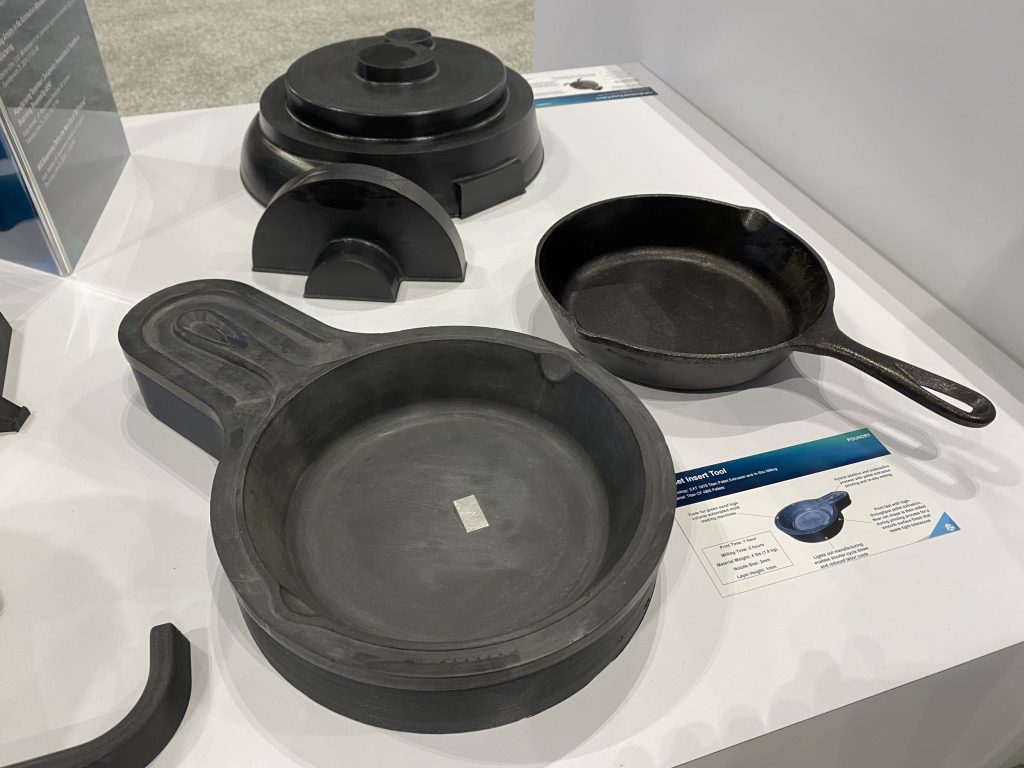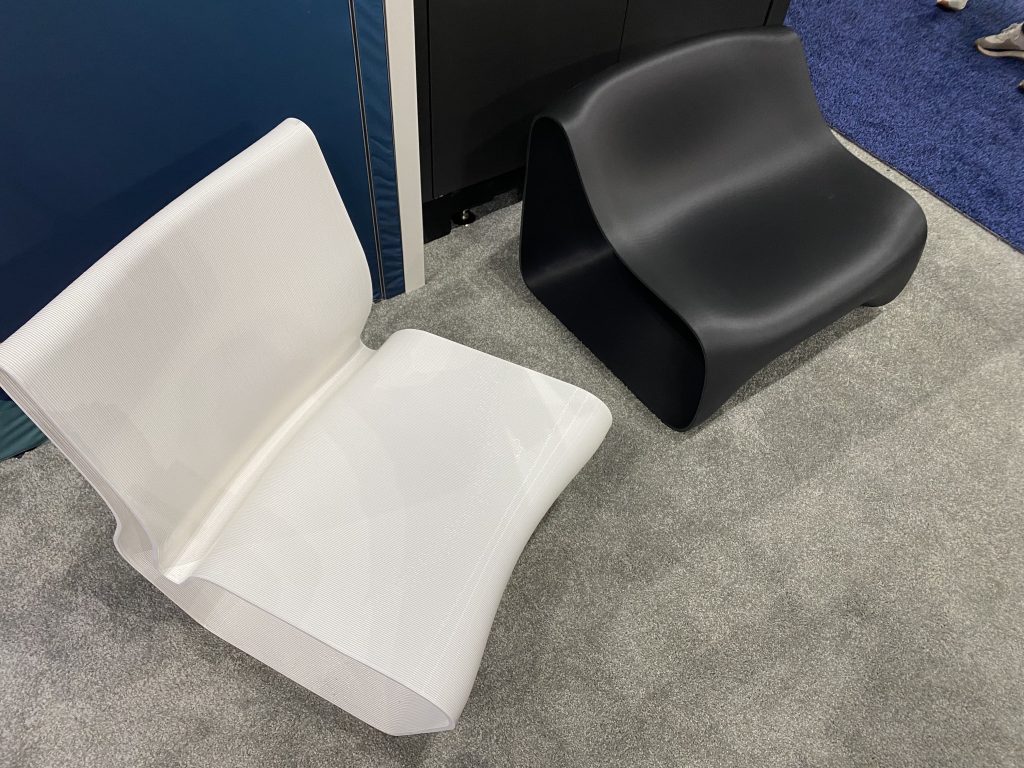At RAPID + TCT 2024, 3D printer manufacturer 3D Systems unveiled the new EXT 800 Titan Pellet, the latest addition to its pellet 3D printer portfolio.
Rahul Kasat, Vice President (VP) at 3D Systems, explained how this new 3D printer meets the growing demand for accessible, large-format production capabilities.
With low upfront costs, affordable feedstock and a compact footprint, Kasat called the EXT 800 an attractive entry-level option for those new to additive manufacturing. It seeks to remove barriers to adoption and targets prototyping, tooling, and end-use production applications.
In keeping with an overarching theme at North America’s largest 3D printing trade show, 3D Systems’ new pellet 3D printer is designed with scalability in mind. Kasat noted that the EXT 800’s high repeatability, automation, and 30 lbs per-hour extrusion rate make it well-suited to production of tens of thousands of parts.
He also outlined the value of pellet 3D printing for distributed manufacturing, overcoming pertinent challenges relating to unpredictable demand, supply chain insecurities, and sustainability targets.
Read all the news from RAPID + TCT 2024

3D Systems launches new EXT 800 Pellet at RAPID + TCT 2024
According to Kasat, the EXT 800 Titan Pellet seeks to address longstanding customer demand for a more compact, cost-effective pellet 3D printer. “We’ve gotten quite a lot of requests for a smaller platform,” Kasat explained.
Boasting a sizeable 800mm x 600mm x 800mm build volume, the EXT 800 features a more compact footprint than the firm’s EXT 1070 Titan and EXT 1270 Titan Pellet 3D printers. Capable of fitting through a standard set of double doors, the system is well-suited to various manufacturing environments, including offices, labs, universities, and large factory floors.
Kasat believes the EXT 800 stands out due to its compatibility with injection molding pellets. These are significantly cheaper than other FDM feedstock, enabling 10x material cost savings over filament-based 3D printers – significantly lowering the barrier to entry for large-format 3D printing.
He also outlined high throughput as a key draw of the new system. Boasting 3D printing speeds that are 10x faster than filament-based systems, the EXT 800 can extrude 30 lbs of material per hour. An industrial CNC-type controller is also incorporated for production reliability.
These features ultimately enable higher machine uptime, lower cost per part, and improved repeatability, explained Kasat. He believes this will facilitate broader adoption within a range of prototyping and manufacturing applications.

Expanding pellet 3D printing applications
At the Los Angeles-based show, 3D Systems showcased two surprisingly comfortable chairs 3D printed on the EXT 800. Kasat highlighted 3D printer furniture as a key use-case of the new large-format system. Indeed, the new pellet extruder has already been adopted by a furniture company in San Francisco.
“They have multiple large-scale machines for printing various furniture parts,” Kasat said. He explained that 3D Systems’ approach to incorporating customer feedback in developing new products has been crucial in designing the EXT 800.
3D Systems pellet extrusion technology is not limited to furniture applications. According to Kasat, the company’s new 3D printer is optimized for applications ranging from large prototypes and thermoforming molds to end-use parts. He argued the ability to use a wide range of materials, including ABS, PLA, carbon fiber composites, and flexible materials like TPUs and TPS, underscores the EXT 800’s flexibility.
Significantly, the company’s pellet extrusion technology has been heavily adopted in the metal forming and thermoforming sectors. “We’ve got traction in the sand casting market,” Kasat added. Here, Titan EXT technology produces casting patterns for traditional metal forming processes.
Moreover, he highlighted the production of flexible polymer parts that cannot be achieved with other 3D printing technologies. For instance, he identified 3D Systems’ thermoplastic polyurethane pellet-based material. “You wouldn’t be able to make a filament of this material, it’s so flexible” he explained.
High-volume production applications are also targeted by the EXT 800 Titan Pellet. This reflects the key theme of scalability which dominated the show floor in Los Angeles. Kasat pointed to one customer who is 3D printing 10,000 Heating, Ventilation, and Air Conditioning (HVAC) parts with the new system. Another client is leveraging EXT Titan Pellet technology to 3D print “thousands” of custom chair backs.
“We’ve already proven that this technology is suitable for bigger opportunities and more parts,” added Kasat. “It is an entry-level, industrial 3D printer that has all the capabilities that our larger platform has.”

Differentiating in the large-scale polymer 3D printer market
When asked how the EXT 800 differentiates within the large-scale polymer 3D printing market, Rahul Kasat highlighted its accessibility and affordability. He reiterated that while the build volume of the EXT 800 is larger than many industrial 3D printers, the real advantage lies in its significantly lower material costs.
The EXT 800 also benefits from the extensive global sales and support network provided by 3D Systems. “We have the largest installed base across the globe,” Kasat noted. The company’s support network spans the US, Europe, and Asia, ensuring comprehensive service for global clients. Smaller competitors, he said, lack this scale in terms of service and sales, giving 3D Systems a unique edge in the 3D printing industry.
According to Kasat, prompt material shipments and responsive customer support further enhance the EXT 800’s appeal. “If they have an issue with the quality of the material, they just need to talk to us,” Kasat added.
3D Systems’ VP also stressed the importance of application versatility, enabled by the company’s large application engineering team. “We have probably three digits of application engineers across the globe,” he explained. This expertise allows the company to assist customers in adapting their EXT 800 to various production needs.
Targeting distributed manufacturing
Kasat discussed the strategic positioning of the EXT 800 in the global market. He addressed the economic considerations for manufacturers looking to scale production using traditional manufacturing methods. “Injection molding is the most cost-effective technology for making millions of parts” he acknowledged.
However, Kasat argued that 3D printing offers unique advantages for distributed manufacturing and spare parts. This is especially valuable “if you need parts in a certain location, and you don’t want to ship those parts.”
By positioning 3D printers strategically around the globe, companies can reduce their carbon footprint and logistical costs. “You don’t need to ship parts around the globe, which reduces carbon emissions,” Kasat added.
This capability is valuable for spare parts, where demand is unpredictable, supply chains are insecure and physical warehousing is costly and inefficient. Kasat highlighted the value of 3D printing spare parts on-demand and at the point of need, “so you don’t need to store them in a controlled environment where you’re burning energy.” He believes these benefits will increase the adoption of EXT Titan Pellet technology.
The 3D printing industry has recently witnessed significant developments in spare parts digitization and distributed manufacturing. Earlier this month, UAE-based 3D printing bureau Immensa and assurance and risk management specialist Det Norske Veritas (DNV) released the “world’s first” global guideline on digitizing spare parts.
The new framework primarily targets energy and power sectors, which are said to spend over $90 billion on spare parts annually. The companies believe the new offering will stimulate sustainable economic growth and increase the global competitiveness of industrial bases worldwide.
Elsewhere, Würth Group’s subsidiary Würth Additive Group introduced its Digital Inventory Services (DIS) at The 2024 Additive Manufacturer User Group (AMUG) Conference. This is advertised as securely transmitting intellectual property, improving quality assurance processes, and facilitating quick distribution of OEM parts.
Register now for AMAA 2024 to hear insights from industry experts on additive manufacturing in aerospace, space, and defense.
Want to help select the winners of the 2024 3D Printing Industry Awards? Join the Expert Committee today.
What does the future of 3D printing hold?
What near-term 3D printing trends have been highlighted by industry experts?
Subscribe to the 3D Printing Industry newsletter to keep up to date with the latest 3D printing news.
You can also follow us on Twitter, like our Facebook page, and subscribe to the 3D Printing Industry Youtube channel to access more exclusive content.
Featured image shows 3D Systems’ new EXT 800 Titan Pellet 3D printer at RAPID + TCT 2024. Photo by 3D Printing Industry.


